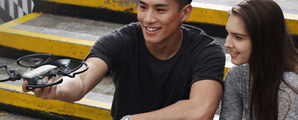FAA & Your Drone
Drone laws can be confusing. The FAA can be confusion. Half Chrome Drones will try and help keep it simple for you.
Disclaimer: Half Chrome does not provide legal advice. For full details visit the disclosures and disclaimers page.

In the United States, the FAA has jurisdiction of the airspace and the FCC makes the rules about RF frequency usage (like those used between a drone and its remote). If you live in another country check what the local laws are. Half Chrome will do an overview of the latest regulations in the United States. Please note that some states and local jurisdictions, notably Washington D.C., have additional rules, so please also check your local laws.
Flying Indoors:
You are in luck, the FAA has no jurisdiction over flights indoors (Source). Of course, we recommend you always fly safely. Flying larger drones indoors is typically not a good plan! Some GPS enabled drones might be much harder to fly indoors where there is no GPS signal, so be careful! Just because you are flying indoors does not mean you are immune from civil and criminal penalties that apply to safety, good judgement, and aggressive behavior.
Flying Outside:
If you are flying outdoors, like most people do, then there are a lot of rules to follow. Rather than list them here, Half Chrome will refer you to the FAA resources listed below. Note that a lot of their summary information is somewhat incomplete and you need a deep dive to get the complete details. For example, in their summary table there is no mention of not flying recklessly, which is clearly forbidden in the document and is one of the main things that will actually get you in trouble. They also say that you must fly during “the day”, this is more clearly spelled out in the official documents (Title 14 of the Code of Federal Regulation (14 CFR) Part 107).
The rules are different for commercial pilots and hobbyist pilots. To learn more about why you might want to become a commercial pilot just so you can fly in more places, read our article about that topic.
Here are some links directly from the FAA’s website that might be helpful.
- Fly a UAS for fun
- Fly a UAS for work or business
- Register your UAS
- Become a UAS pilot (coming soon)
- Apply for a waiver to Part 107 (coming soon)
The FAA has even developed an app to help drone pilots determine if they are flying in a safe location. Note that this app identifies every single little air strip and helipad. It tells you where the hobbyist pilot can’t fly without permission. Commercial pilots have fewer restrictions. To learn more read our article on this topic.

B4UFLY a drone app developed by FAA
The table below is straight from the FAA’s website from the summer of 2016 and it gives a good summary of the requirements, although the table isn’t super well organized. (Source)
| Fly for Fun | Fly for Work | |
| Pilot Requirements | No pilot requirements | Must have Remote Pilot Airman Certificate Must be 16 years old Must pass TSA vetting |
| Aircraft Requirements | Must be registered if over 0.55 lbs. | Must be less than 55 lbs. Must be registered if over 0.55 lbs. (online) Must undergo pre-flight check to ensure UAS is in condition for safe operation |
| Location Requirements | 5 miles from airports without prior notification to airport and air traffic control | Class G airspace* |
| Operating Rules | Must ALWAYS yield right of way to manned aircraft Must keep the aircraft in sight (visual line-of-sight) UAS must be under 55 lbs. Must follow community-based safety guidelines Must notify airport and air traffic control tower before flying within 5 miles of an airport | Must keep the aircraft in sight (visual line-of-sight)* Must fly under 400 feet* Must fly during the day* Must fly at or below 100 mph* Must yield right of way to manned aircraft* Must NOT fly over people* Must NOT fly from a moving vehicle* |
| Example Applications | Educational or recreational flying only | Flying for commercial use (e.g. providing aerial surveying or photography services) Flying incidental to a business (e.g. doing roof inspections or real estate photography) |
| Legal or Regulatory Basis | Public Law 112-95, Section 336 – Special Rule for Model Aircraft FAA Interpretation of the Special Rule for Model Aircraft | Title 14 of the Code of Federal Regulation (14 CFR) Part 107 |
*These rules are subject to waiver.
Not sure what is the best drone for you???
No worries, Half Chrome Drones has you covered. Maybe you want an aerial photography drone, or maybe you want a fun toy. Want FPV? We’ve developed an advanced system to match you to the right drone. We call it our Half Chrome Drone Cipher™, go check it out. We also are constantly updating our Best Drones Now page to help you stay current.
Disclosure:
This website contains affiliate links, which means we receive a commission if you make a purchase using these links. For full details visit the disclosures and disclaimers page.
- Beginner
- Discounts
- Wedding
- Youth
















